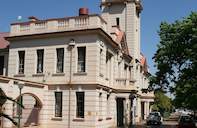Gateway to the North
Potchefstroom went from being a quiet farming village to bustling town within 75 years. Today, Potchefstroom is known as the ‘Gateway to the North’, as it is still a popular stopover spot for travellers locally and internationally.

Potchefstroom was laid out along the banks of the Mooi River in November 1838 after a Voortrekker party, led by Commandant Andries Potgieter, settled in the area.
The first Voortrekker congregation North of the Vaal River was established at Potchefstroom in March 1842, and the settlement also served as the first capital of the Zuid-Afrikaansche Republiek (ZAR) from 1857 until it was moved to Pretoria. The opening shots of the War of Independence (1880-81) were fired at Potchefstroom in December 1880, beginning a 95-day Boer siege of the town's historic Fort.
Potchefstroom’s location on the border of the province and the then new republic caused it to become a growing commercial centre. Markets, shops and homes started being built around the first church from 1851, and soon a town hall was also erected.
Potchefstroom also became a popular stopover for travellers going up North to hunt big game or visit the wildlife. This resulted in the erection of the Royal Oak Hotel in 1860 to accommodate the many travellers coming through.
Historic Buildings of Potchefstroom
The Goetz/Fleischack Museum in Potchefstroom showcases the only surviving example of the typical townhouses built around the town's market square in the 1850s. The house shows what daily life was like for the early settlers who became well to do middle class that benefited from the trading industry. The house has a strong Victorian style, with a mix of locally used materials.
The Potchefstroom Museum focuses on the history and development of the area and has a valuable collection of paintings by Otto Landsberg. Landsberg’s works depict some of the earliest landscapes and developments in South Africa. His works offer a wonderful look into the past lives of early South African life of the settlers.
Some of Potchefstroom's historic buildings include the cruciform-shaped Dutch Reformed Church known as Die Nederduitsch Hervormde Kerk, completed in 1866 on the site of an earlier church, as well as The Old Presidency (1868) or MW Pretorius House, a small traditional Cape style house where the first President, Marthinus Pretorius of the ZAR (South African Republic) lived for many years.
These sites offer a deeper look into the strong connection between the beliefs and politics that formed the very foundation of the settlement for the colony and the rest of South Africa’s history.
Other noteworthy buildings include the neo-Renaissance-style Landdrost (Magistrate's) Offices (1895) and Totius House (1906). The Totius House was the residence of Dr Jacob du Toit, the Afrikaans author, poet who translated the Bible into Afrikaans.